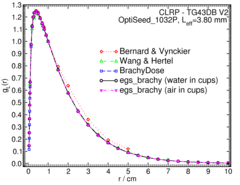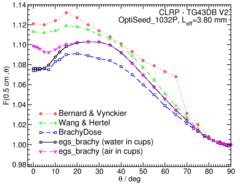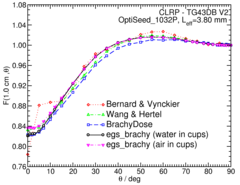
Source Description:
The dimensions for the OptiSeed 1 are taken from the study by Bernard and Vynckier 1. Encapsulation for the OptiSeed is made of bio-compatible polymer (the exact polymer is unknown and assumed to be polyethylene) with inner and outer diameters of 0.40 mm and 0.80 mm, respectively. The ends are sealed with a 0.60 mm long cylindrical piece of polymer (diameter 0.80 mm). The ends are formed into spherical ``cups''. In this study, the cups are assumed to be water filled spheres that are 0.40 mm in diameter and have their centers shifted 2.35 mm from the center of the source. Directly adjacent to the end cups are 0.70 mm long and 0.40 mm diameter polymer cylinders (assumed to be polystyrene) with 103Pd uniformly distributed throughout. The amount of 103Pd present in the polymer is assumed to be negligible. At the center of the source, there is a 2.0 mm long Au cylinder with an outer diameter assumed to be just larger than the inner diameter of the polymer tube (0.450 mm). The space between the polymer cylinders and Au marker is assumed to be air. The overall source length is 5.0 mm and the active length is 3.80 mm. Wang et al study 2, supposed the outer diameter of the source is 0.810 mm, and the central Au marker has a length of 2.0 mm and diameter of 0.5 mm. A study by Aboud et al 3 designed a source identical to the Optiseed, but the Au marker is replaced with a biocompatible polymer material and they changed the active length of the source from 3.80 mm to 3.70 mm. The mean photon energy calculated on the surface of the source is 20.54 keV with mean statistical uncertainties < 0.01%.
(Note: The previous database used inner and outer diameters of 0.0225 mm and 0.0405 mm for the seed, and also an outer diameter of 0.05 mm for the Au marker. These geometry modifications on average changed radial dose functions about 13% but just very close to the source (0.05 cm <r<0.1 cm) where the very steep gradient meant there is a very small distance to agreement. The 2D anisotropy function changed up to 4% for r<0.5 cm).
(Note: Considering air or water in cups of the end caps (the concave holes at either end) of the source, generated a negligible difference (0.05%) in the DRC and radial dose function, and a mean differences in the 2D anisotropy function below 3% at r ≤ 2.0 cm for angles close to 0 ° ).
Dose-Rate Constant - Λ :
Dose-rate constants, Λ , are calculated by dividing the dose to water per history in a (0.1 mm)3 voxel centered on the reference position, (1 cm, Π/2), in a 30x30x30 cm3 water phantom, by the air-kerma strength per history (scored in vacuo ). As described in ref. 4 , dose-rate constants are provided for air-kerma strength calculated using voxels of 2.66x2.66x0.05 cm3 (WAFAC) and 0.1x0.1x0.05 cm3 (point) located 10 cm from the source. The larger voxel size averages the air kerma per history over a region covering roughly the same solid angle subtended by the primary collimator of the NIST WAFAC 5,6 used for calibrating low-energy brachytherapy sources and is likely the most clinically relevant value. The small voxel serves to estimate the air kerma per history at a point on the transverse axis and includes a small 1/r2 correction (0.5%) 4. MC uncertainties are only statistical uncertainties (k=1).
| Author | Method | Λ (cGy h-1 U-1) | Abs. Uncertainty |
| Safigholi et al 7 | WAFAC | 0.6668 | 0.0001 |
| Safigholi et al 7 | point | 0.667 | 0.0001 |
| Taylor, Rogers 8 | WAFAC | 0.669 | 0.002 |
| Taylor, Rogers 8 | point | 0.670 | 0.002 |
| Bernard, Vynckier 1 | TLD (Solid Water) | 0.720 | 0.06 |
| Bernard, Vynckier 1 | Point (MCNP) | 0.712 | 0.06 |
| Wang, Hertel 2 | Point (MCNP) | 0.665 | 0.021 |
| Wang, Hertel 2 | TLD | 0.675 | 0.075 |
| Abboud et al 3 | TLD (Solid Water) | 0.710 | 0.07 |
| Abboud et al 3 | Point (MCNP) | 0.672 | 0.01 |
| Rodriguez, Rogers 9 | BrachyDose (WAFAC) | 0.669 | 0.002 |
| Rivard et al 10 | TG-43U1S1 (Consensus Vlaue) | 0.671 | 0.019 |
Radial dose function - g(r):
The radial dose function, g(r), is calculated using both line and point source geometry functions and tabulated at 36 different radial distances ranging from 0.05 cm to 10 cm. Fit parameters for a modified polynomial expression are also provided 11 . The mean residual deviations from the actual data for the best fit were < 0.11%.
| Fitting coefficients for g L (r) = (a0 r-2 + a1 r-1 + a2 + a3r + a4r2 + a5 r3) e-a6r | |||
| Fit range | Coefficients | ||
| r min (cm) | r max (cm) | ||
| 0.10 | 10.00 | a0 / cm2 | (1.18+/-0.05)E-03 |
| a1 / cm | (-1.283+/-0.007)E-01 | ||
| a2 | (1.844+/-0.004)E+00 | ||
| a3 / cm-1 | (2.20+/-0.17)E-01 | ||
| a4 / cm-2 | (-4.08+/-0.06)E-02 | ||
| a5 / cm-3 | (2.82+/-0.06)E-03 | ||
| a6 / cm-1 | (6.43+/-0.08)E-01 | ||
Anisotropy function - F(r,θ):
Anisotropy functions are calculated using the line source approximation and tabulated at radii of 0.1, 0.15, 0.25, 0.5, 0.75, 1, 2, 3, 4, 5, 7.5 and 10 cm and 32 unique polar angles with a minimum resolution of 5° . The anisotropy factor, φan (r), was calculated by integrating the solid angle weighted dose rate over 0° ≤ ϑ ≤ 90° .
Tabulated data:
Tabulated data are available in .xlsx format: Excel
References:
1. S. Bernard, S. Vynckier, Dosimetric study of a new polymer encapsulated 103Pd seed, Phys. Med. Biol., 50 , 1493-1504, 2005
2. Z. Wang, N.E. Hertel, Determination of dosimetric characteristics of OptiSeed a plastic brachytherapy 103Pd source, Appl. Radiat. Isotopes, 63 , 311-321, 2005
3. F. Abboud, P. Scalliet, and S. Vynckier, An experimental palladium-103 seed (OptiSeed exp) in a biocompatible polymer without a gold marker: Characterization of dosimetric parameters including the interseed effect, Med. Phys., 35 , 5841-5850, 2008. 4. R. E. P. Taylor et al , Benchmarking BrachyDose: voxel-based EGSnrc Monte Carlo calculations of TG-43 dosimetry parameters, Med. Phys., 34 , 445-457, 2007.
5. R. Loevinger, Wide-angle free-air chamber for calibration of low-energy brachytherapy sources, Med. Phys., 20 , 907, 1993
6. S. M Seltzer et al , New National Air-Kerma-Strength Standards for 125I and 103Pd Brachytherapy Seeds, J. Res. Natl. Inst. Stand. Technol.,108,337-358,2003. 7. H. Safigholi, M. J. P. Chamberland, R. E. P. Taylor, C. H. Allen, M. P. Martinov, D. W. O. Rogers, and R. M. Thomson, Updated of the CLRP TG-43 parameter database for LDR low-energy brachytherapy sources, to be published (Current calculation).
8. R. E. P. Taylor, D. W. O. Rogers, An EGSnrc Monte Carlo-calculated database of TG-43 parameters, Med. Phys., 35 , 4228--4241, 2008
9. M. Rodriguez, D. W. O. Rogers, On determining dose rate constants spectroscopically, Med. Phys. 40 , 011713-10, 2013. 10. M. Rivard et al , Supplement 2 for the 2004 update of the AAPM Task Group No. 43 Report: Joint recommendations by the AAPM and GEC-ESTRO, Med. Phys. 44 , e297-e338, 2017. 11. R. E. P. Taylor, D. W. O. Rogers, More accurate fitting of 125I and 103Pd radial dose functions, Med. Phys., 35 , 4242-4250, 2008


